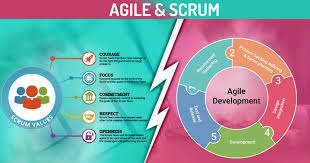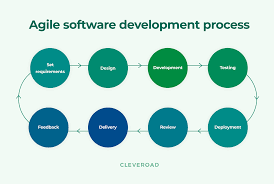Mastering Agile Development Through Scrum: A Guide to Success
Agile Development: Understanding Scrum
Agile development has revolutionized the way software is built and delivered. Among the various methodologies within agile, Scrum stands out as one of the most popular and widely adopted frameworks.
What is Scrum?
Scrum is a lightweight, iterative approach to software development that emphasizes collaboration, flexibility, and continuous improvement. It is based on the principles of transparency, inspection, and adaptation.
Key Components of Scrum
Scrum consists of several key components:
- Sprints: Sprints are time-boxed iterations, usually lasting 1-4 weeks, during which a set of features or user stories are developed and delivered.
- Scrum Team: The Scrum Team typically consists of a Product Owner, Scrum Master, and Development Team. They work together to deliver value in each sprint.
- Product Backlog: The Product Backlog is a prioritized list of features or user stories that need to be developed. It evolves throughout the project based on feedback and changing requirements.
- Sprint Planning: At the beginning of each sprint, the team selects items from the Product Backlog to work on during that sprint.
- Daily Standups: Daily standup meetings are held to keep the team aligned and address any obstacles or issues that may arise.
- Sprint Review: At the end of each sprint, a Sprint Review meeting is held to demonstrate completed work to stakeholders and gather feedback.
- Sprint Retrospective: The Sprint Retrospective allows the team to reflect on what went well and what could be improved in future sprints.
The Benefits of Scrum
Scrum offers several benefits to development teams and organizations, including:
- Rapid delivery of working software
- Increased collaboration and communication
- Faster response to changing requirements
- Better visibility into project progress
- Continuous improvement through regular feedback loops
In Conclusion
Scrum is a powerful framework that enables teams to deliver high-quality software in a fast-paced and dynamic environment. By embracing its principles and practices, organizations can adapt more effectively to change and deliver value to their customers more efficiently.
Understanding Agile Development: Key FAQs About Scrum Methodology
- What is agile development and how does it differ from traditional methodologies?
- What is Scrum and how does it fit into the agile framework?
- What are the key roles in a Scrum team?
- How long are sprints in Scrum and why are they time-boxed?
- What is a Product Backlog and how is it managed in Scrum?
- What is the difference between Sprint Planning, Daily Standups, Sprint Review, and Sprint Retrospective?
- How does Scrum promote collaboration and communication within a development team?
- What are the benefits of using Scrum for software development projects?
What is agile development and how does it differ from traditional methodologies?
Agile development is a modern approach to software development that emphasizes flexibility, collaboration, and adaptability. Unlike traditional methodologies like Waterfall, which follow a linear and sequential process, agile development is iterative and incremental. Agile projects are divided into small, manageable iterations called sprints, allowing for continuous feedback and adaptation. This iterative approach enables teams to respond quickly to changing requirements and deliver value to customers more efficiently. Agile also promotes close collaboration between cross-functional team members, encouraging communication and teamwork throughout the development process. Overall, agile development prioritizes customer satisfaction, quality deliverables, and the ability to respond effectively to evolving project needs.
What is Scrum and how does it fit into the agile framework?
Scrum is a popular agile framework that emphasizes iterative and incremental development practices to deliver high-quality software efficiently. It is characterized by its focus on collaboration, adaptability, and continuous improvement. Within the broader agile framework, Scrum serves as a specific methodology that provides a structured approach to project management and product development. By breaking down work into manageable chunks called sprints and following key ceremonies like sprint planning, daily standups, sprint reviews, and retrospectives, Scrum helps teams prioritize tasks effectively, respond to changes quickly, and deliver valuable increments of work at regular intervals. In essence, Scrum is a key component of the agile methodology that enables teams to work collaboratively towards achieving their project goals in a flexible and adaptive manner.
What are the key roles in a Scrum team?
In a Scrum team, there are three key roles that play essential parts in the successful implementation of the framework. The Product Owner is responsible for representing the stakeholders’ interests, prioritizing the work, and ensuring that the team delivers value to the business. The Scrum Master acts as a facilitator, helping the team understand and adopt Scrum principles, removing impediments, and fostering a collaborative environment. Lastly, the Development Team consists of professionals who are responsible for delivering potentially shippable increments of product at the end of each sprint. Each role has unique responsibilities that contribute to the overall effectiveness and efficiency of the Scrum team.
How long are sprints in Scrum and why are they time-boxed?
In Scrum, sprints typically last between 1 to 4 weeks, with the most common duration being 2 weeks. Sprints are time-boxed to provide a clear and consistent cadence for the team to work within. By having a fixed timeframe, teams can focus on delivering a specific set of features or user stories without getting sidetracked by changing priorities or scope creep. The time-boxed nature of sprints also encourages a sense of urgency and helps teams maintain a sustainable pace of work throughout the project. Additionally, shorter sprints allow for more frequent feedback and opportunities for course correction, leading to faster delivery of value to stakeholders.
What is a Product Backlog and how is it managed in Scrum?
In Agile development using Scrum, the Product Backlog plays a crucial role as a dynamic and prioritized list of features, enhancements, and fixes that need to be developed for a product. It serves as the single source of requirements for any changes to be made to the product. The Product Backlog is managed by the Product Owner, who is responsible for continuously refining and prioritizing the items based on feedback, changing market conditions, and business needs. The items at the top of the Product Backlog are typically more detailed and ready for implementation in upcoming sprints, while those at the bottom are still in need of refinement. Regular collaboration between the Product Owner, Development Team, and stakeholders ensures that the Product Backlog remains relevant and aligned with the project’s goals throughout the development process.
What is the difference between Sprint Planning, Daily Standups, Sprint Review, and Sprint Retrospective?
In agile development using the Scrum framework, Sprint Planning, Daily Standups, Sprint Review, and Sprint Retrospective are essential ceremonies that play distinct roles in the iterative software development process. Sprint Planning marks the beginning of each sprint, where the team collaborates to select and commit to work from the Product Backlog for that iteration. Daily Standups are brief meetings held every day to synchronize team members, discuss progress, and identify any obstacles hindering their work. Sprint Review occurs at the end of a sprint and involves showcasing completed work to stakeholders for feedback. Lastly, the Sprint Retrospective allows the team to reflect on their processes and performance during the sprint, identifying areas for improvement in future iterations. Each of these events contributes to the transparency, collaboration, and continuous improvement that are core principles of Scrum methodology.
How does Scrum promote collaboration and communication within a development team?
Scrum promotes collaboration and communication within a development team through its structured framework and practices. By emphasizing the importance of cross-functional teams working together towards a common goal, Scrum encourages regular interaction and information sharing. Daily standup meetings provide an opportunity for team members to synchronize their efforts, discuss progress, and address any obstacles. Additionally, the sprint planning, review, and retrospective meetings facilitate open communication, feedback exchange, and continuous improvement. The transparent nature of Scrum, with its visible progress tracking and regular feedback loops, fosters a culture of collaboration where team members feel empowered to share ideas, raise concerns, and work together towards delivering high-quality software efficiently.
What are the benefits of using Scrum for software development projects?
One of the frequently asked questions about agile development Scrum is, “What are the benefits of using Scrum for software development projects?” Using Scrum in software development projects offers numerous advantages. It enables teams to deliver working software rapidly, promotes increased collaboration and communication among team members, facilitates a faster response to changing requirements, provides better visibility into project progress, and fosters continuous improvement through regular feedback loops. By embracing Scrum’s principles and practices, organizations can adapt more effectively to change and deliver value to their customers more efficiently.





